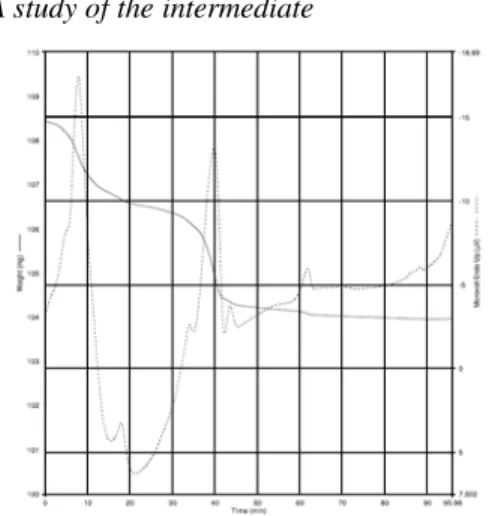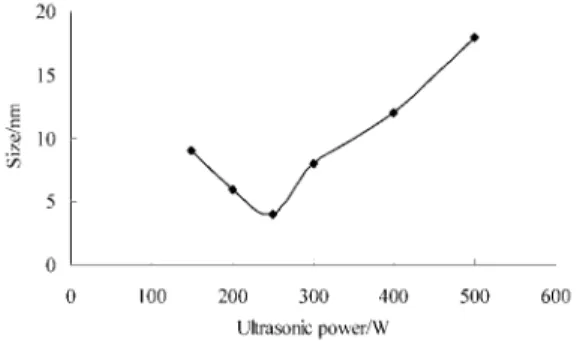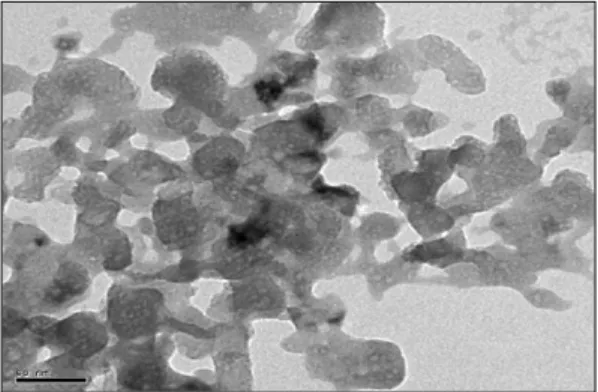Introduction
The alteration of the bulk electronic structure of nanosized materials causes change in the total energy of the system, so that, ignor-ing entropy considerations, it will thermody-namically stabilize the reduced scale system rel-ative to that of normal bulk crystals. Such alter-ations may change the most energetically stable form of a particular material, as when small nanoparticles or nanodimensional layers adopt a crystal structure different from that of the nor-mal bulk material. The surface area to volume ratio (S/V) and the specific surface area of a sys-tem are inversely proportional to particle size. Both S/V and specific surface area increase drastically for particles less than 100 nm in diameter. Reduction of the system size may change the chemical reactivity and physical
properties such as electrical, thermal, optical and magnetic characteristics [1, 2].
Due to their different physical and chemical properties, nano-structured materials have received increasing attention in various fields of science and technology [3–5]. A variety of physicochemical methods, including metal evaporation [6], spray pyrolysis [7], sol–gel [8], hydrothermal synthesis [9] and electrochemical methods [10], have been used to produce nanometer-sized materials.
Recently, the sonochemical methods have been shown to be very promising in the prepara-tion of a variety of materials with nanometer dimensions, including nanochalcogenides [11, 12], metallic nanoparticles [13, 14] and nano-sized metal oxides [15, 16]. These materials pos-sess improved magnetic properties [17], energy storage capacities [18–20] and photocatalytic [21] and catalytic properties [22].
www.scielo.br/eq www.ecletica.iq.unesp.br
Volume 33, número 1, 2008
Preparation of nano-MgO using ultrasonic
method and its characteristics
Zhen-Xing Tang*, Lu-E Shi
College of Pharmaceutical Science, Zhejiang University of Technology, 310014, Hangzhou, Zhejiang, P R China *tangzhenxing@126.com
Abstract:MgO is an important inorganic material, which can be used in many aspects, such as cata-lyst, toxic-waste remediation agent, adsorbent, and others. In order to make use of MgO, nano-MgO was prepared by ultrasonic method using Mg (CH3COO)2.2H2O as precursor, NaOH aqueous solution as precipitant in this paper. Effect factors on MgO nano-particle size were investigated. Characteristics of samples were measured by TGA, XRD, TEM, and others techniques. The results showed that the size of nano-MgO about 4 nm could be obtained under the following conditions (ultrasonic time 20 min, ultrasonic power 250 W, titration rate of NaOH 0.25 mL/min, NaOH concentration 0.48 mol/L, calcinations temperature 410 °C, calcination time 1.5 h, heating rate of calcination 5 °C/min). It was a very simple and effective method to prepare nano-MgO.
MgO is an exceptionally important mate-rial, which used in catalyst, toxic-waste remedia-tion agent, or as an additive in refractory, paint as well as for fundamental and application studies [23]. Ultra-fine metal oxide particles can be used as bactericide, adsorbent, and catalyst. MgO in particular has shown great promising application as a destructive adsorbent for toxic chemical agent [24]. This paper presented an ultrasonic route for preparing MgO nano-particles. Effect factors on MgO nano-particle size were investi-gated. It is a good method to prepare nano-MgO.
Experimental details Materials
Mg (CH3COO)2. 2H2O (Mallinkrodt baker inc, ACS); Sodium hydroxide (BMD chemicals inc, ACS); Other reagents were gotten from local supplies.
Preparation of MgO nano-particles
Mg (CH3COO)2. 2H2O was dissolved in ethanol solution. Then NaOH solution was titrated into the above solution under ultra-sound. After it being sonicated about 20 min, the transparent solution could be gotten. All organic substances were removed by reduced distillation. Then it was dried at 50 °C for about 1.5 h under vacuum condition. Finally, MgO nano-particles with different sizes could be obtained through calcining.
Analysis Methods
TGA measurements were carried out using Netzsch STA 409 Apparatus; The size and Particle size distribution in ethanol was record-ed on Submicron Particle Sizer (NICOMP 370, USA); TEM photomicrographs were obtained using Philips 201 Transmission Electron Microscope. The pictures were taken at 80 kV. The deposit was scraped away from the support and then transferred to the Fromvar 1595 E (Merck) membrane coated Cu grid (mesh 400); Rigaku Geiferflex X-ray diffractometer with Ni-filtered Cu Ka radiation (40 kV, 30 mA) was used to determine the crystallinity and phase of the samples.
Results and Discussion TGA study of the intermediate
Figure 1.TGA of Mg(OH)2-Conditions: hold for 1 min at 50 °C; heat from 50 °C to 1000 °C at the rate 10 °C/min; hold for 1 h at 1000 °C.
Decomposition temperatures are different for different intermediates. Decomposition tem-perature of the same intermediates is relative to the precursors [25-27].For example, Mg(OH)
2can
be obtained from the precursor MgSO4.7H2O,
Mg(CH3CO3)2.4H2O and Mg(NO3)2.6H2O.
Decomposition temperature of Mg(OH)2is about
920 °C, 310 °C, 390 °C, respectively. The last two intermediates can be decomposed into MgO below 400 °C. But, for the first intermediate, MgO can be obtained when the temperature is more than 900 °C.
To further characterize the intermediate, TGA profiles was measured. According to TGA of the intermediate (Fig. 1), we could know the sample was MgO. MgO nano-particles could be gotten at 410 °C through calcining of the inter-mediate in our paper. The calcinations tempera-ture was lower than the results reported by Wu Shan[27]. Ethanol mediated magnesium
Effect of factors on MgO nano-particle size
Effect of NaOH concentration on the size For precipitant method, the ratio (the nucle-ant rate: the crystal growth rate) is increased with the increasing of reactant concentration when reac-tant concentration is at certain concentration scope. Nano-particle size turns smaller along with the increasing of reactant concentration at this concen-tration scope too. When the reactant concenconcen-tration oversteps this certain concentration, although the nucleant rate is very fast, it is easy to get big size nano-particle due to high particle density, high impact probability and the serious aggregation of particles. So with the increasing of reactant con-centration, the trend of particle size is decreased first, and then increased [28]. When the ultrasound is
introduced into this method, the nucleant rate is further increased [29-32]. Vast amount of micro air
bubble is formed due to ultrasonic cavitate. These micro air bubbles can disturb the ordered crystal sequence. It will affect the crystal growing further. Shock wave with high pressure and micro-emis-sion fluid produced by ultrasonic cavitate, can bring comminution and emulsification, stir, and others mechanical influences. It can effectively prevent the crystal growth and aggregation. This influence makes the nucleant rate far higher than precipitant method’s. The small size nano-particle with uniform size distribution is easy to be obtained[30-33]. However, this influence is relative
to super-saturation solution. If the super-saturation degree is low, it can be effective. If the super-satu-ration degree is high, the crystal growth rate is too
Figure 2.Effect of NaOH concentration on the size. Conditions: Ultrasonic time: 20 min; Ultrasonic power: 250 W; titration rate of NaOH: 0.25 mL/min; Calcinations temperature: 410 °C; Heating rate of calcinations: 5 °C/min; Calcinations time: 1.5 h.
fast. The ultrasound has little effect on the crystal growth rate. But the mechanical influence pro-duced by ultrasonic cavitate can prevent the crystal growing. When super-saturation is increased fur-ther, both have little influence on the crystal growth rate. This phenomenon is the same with general precipitant method [34]. From Fig.2, we could know
the smallest size was about 5 nm when NaOH con-centration was 0.48 mol/L.
Effect of titration rate of NaOH on the size
Figure 3. Effect of titration rate on the size. Conditions: Ultrasonic time: 20 min; Ultrasonic power: 250 W; NaOH concentration: 0.48 mol/L; Calcinations temperature: 410 °C; Heating rate of calcinations: 5 °C/min; Calcinations time: 1.5 h.
From Figure 3, the size was similar when titration rate of NaOH was below 0.25 mL/min. With the decrease of titration rate, the size of nano-particles became smaller. The concentration of nano-particles was low. And vast amount of crystal were formed due to ultrasonic cavitate. At the same time, the mechanical influence produced by ultra-sonic cavitate such as comminution, emulsifica-tion, stir, and others, was increased with prolonging of titration rate. Thus, it could prevent the nano-particle growing and aggregating.
Effect of ultrasonic time on the size
Figure 4. Effect of ultrasonic time on the size. Conditions: Titration rate of NaOH: 0.25 mL/min; Ultrasonic power: 250 W; NaOH concentration: 0.48 mol/L; Calcinations temperature: 410 °C; Heating rate of calcinations: 5 °C/min; Calcinations time: 1.5 h.
Effect of ultrasonic power on the size
From Figure 5, we could know when ultra-sonic power was low (about 250 w), the influence on the size was little. With the increasing of power, the temperature of the system was increased. The adverse effect of ultrasonic power on nano-parti-cles nucleation, growth and formation appeared. The big size nano-particle was easy to obtain. So the optimized ultrasonic power was 250 W.
Effect of calcinations temperature and calcina-tions time on the size
Calcinations techniques are crucial to get nano-MgO with small size and high surface area. When calcinations temperature is low, the interme-diate might not be decomposed completely. It must prolong calcinations time to make the intermediate
Figure 5. Effect of ultrasonic power on the size. Conditions: Titration rate of NaOH: 0.25 mL/min; Ultrasonic time: 20 min; NaOH concentration: 0.48 mol/L; Calcinations temperature: 400 °C; Heating rate of calcinations: 5 °C/min; Calcinations time: 1.5 h.
Figure 6.Effect of calcinations temperature on the size. Conditions: Titration rate of NaOH: 0.25 mL/min; Ultrasonic time: 20 min; NaOH concentration: 0.48 mol/L; Ultrasonic power: 250 W; Heating rate of calci-nations: 5 °C/min; Calcinations time: 1.5 h.
decomposed. Different size crystal has different vapour pressure. Vapour pressure of small size crystal is high. And vapour pressure of big size crystal is low. So the process that small size crystal turn into big size crystal will happen automatically. The process (small size crystal is disappeared and big size crystal grow bigger than before) proceeds very quickly, especially at high temperature. With the calcinations time being prolonged, the process will be achieved completely. Because the crystal exists for a long time at high calcinations tempera-ture, the crystal size is easy to become bigger. Thus, nano-particles with big size and wide size distribution can be gotten. For the same reason, although the intermediate can be completely decomposed quickly at high calcinations tempera-ture, nano-particle with big size is easy to be obtained due to aggregation. So, in order to get nano-particle having small size and high surface area, calcinations temperature should not be too high and calcinations time should not be too long.
inter-mediate was not decomposed completely. Thus, through controlling calcinations temperature and calcinations time, nano-MgO with different sizes could be obtained. In order to get smaller size par-ticles, Calcinations temperature was about 410 °C and calcinations time was 1.5 h.
Figure 7. Effect of calcinations time on the size. Conditions: Titration rate of NaOH: 0.25 mL/min; Ultrasonic time: 20 min; NaOH concentration: 048 mol/L; Ultrasonic power: 250 W; Calcinations temper-ature: 410 °C; Heating rate of calcinations: 5 °C/min.
Effect of heating rate of calcinations on the size Heating rate of calcinations can affect nano-particle size. When heating rate of calcinations is very fast, big size nano-MgO aggregation is easy to be gotten due to urgent collapse of the intermediate. When heating rate of calcinations is low, nano-MgO may exist for a long time at high calcinations temperature. What’s more, it will decrease produc-tion efficiency. So, optimized heating rate of calci-nations must exist. Effect of heating rate of calcina-tions on the size of nano-MgO was presented in Fig.
8. From Fig. 8, we could know that heating rate of calcinations had little effect on the size. With the increased heating rate, the size of nano-MgO was decreased. When heating rate was in the range of 5-10 °C/min, the size nearly did not change. Thus, Optimized heating rate was 5-10 °C/min.
The sizes distribution was presented in Fig.9. From Fig.9, the sizes distribution was narrow. Nano-MgO size was between 12 nm and 18 nm. The distribution was consistent with XRD result.
Figure 8.Effect of heating rate of calcinations on the size. Conditions: Titration rate of NaOH: 0.25 mL/min; Ultrasonic time: 20 min; NaOH concen-tration: 0.48 mol/L; Ultrasonic power: 250 W; Calcinations temperature: 410 °C.
Structural and Morphologies characterizations of nano-MgO
TEM of MgO nano-particles were illustrat-ed in Fig.10. From Fig.10, MgO nano-particles could be dispersed very well in ethanol. Few aggre-gate could be found. MgO powder appeared with an Figure 9. The sizes distribution of MgO nano-par-ticles. Nano-particles were obtained at calcinations temperature 650 °C, calcinations time 1.5 h, heating rate 5 °C/min.
[2] M. Di Ventra, Introduction to Nanoscale Science and Technology, Springer, 2004
[3] L. Tosheva, V.P. Valtchev, Chem. Mater. 17 (2005) 2494 [4] E. Manova, T. Tsoncheva, D. Paneva, I. Mitov, K. Tenchev, L. Petrov, Appl. Catal. A: Gen 277 (2004) 119 [5] Mao-Sung Wu, Pin-Chi J. Chiang, Jyh-Tsung Lee, Jung-Cheng Lin, J. Phys. Chem. B 109 (2005) 23279
[6] L. Carbone, S. Kudera, E. Carlino, W.J. Parak, C. Giannini, R. Cingolani, L. Manna, J. Am. Chem. Soc. 128 (2006) 748
[7] M. Regragui, M. Addou, A. Outzourhit, J.C. Bernede, E.E. Idrissi, E. Benseddik, A. Kachouane, Thin Solid Films 358 (2000) 40
[8] J. Xie, X. Cao, J. Li, H. Zhan, Y. Xia, Y. Zhou, Ultrason. Sonochem. 12 (2005) 289
[9] E. Shen, C. Wang, E. Wang, Z. Kang, L. Gao, C. Hu, L. Xu, Mater. Lett. 58 (2004) 3761
[10] Kh. Ghanbari, M.F. Mousavi, M. Shamsipur, Electrochim. Acta 52 (2006) 1514.
[11] S.F. Wang, F. Gu, M.K. Lu¨ , Langmuir 22 (2006) 398 [12] Jin-Zhong Xu, Shu Xu, Jun Geng, Gen-Xi Li, Jun-Jie Zhu, Ultrason. Sonochem. 13 (2006) 451
[13] Sheng-Yi Zhang, Y. Liu, X. Ma, Hong-Yuan Chen, J. Phys. Chem. B 110 (2006) 9041
[14] H. Lei, Y.-J. Tang, J.-J. Wei, J. Li, X.-B. Li, H.-L. Shi, Ultrason. Sonochem. 14 (2007) 81
[15] V.G. Kumar, K.B. Kim, Ultrason. Sonochem. 13 (2006) 549 [16] Chang-Jie Mao, Hong-Cheng Pan, Xing-Cai Wu, Jun-Jie Zhu, Hong- Yuan Chen, J. Phys. Chem. B 110 (2006) 14709 [17] K.S. Suslick, M. Fang, T. Hyeon, J. Am. Chem. Soc. 118 (1996) 11960
[18] H. Zhou, Z. Zhou, Solid State Ionics 176 (2005) 1909 [19] Q.S. Song, Y.Y. Li, S.L.I. Chan, J. Appl. Electrochem. 35 (2005) 157
[20] J. Zhu, Z. Lu, S.T. Aruna, D. Aurbach, A. Gedanken, Chem. Mater. 12 (2000) 2557
[21] J.C. Yu, J. Yu, L. Zhang, W. Ho, J. Photochem. Photobiol. A: Chem. 148 (2002) 263
[22] L. Jiang, G. Sun, Z. Zhou, S. Sun, Q. Wang, S. Yan, H. Li, J. Tian, J. Guo, B. Zhou, Q. Xin, J. Phys. Chem. B 109 (2005) 8774
[23] S.H. Liang, I.D. Gay, J. Catal. 1986, 101, 293 [24] H. Tsuji, F. Yagi, H. Hattori, H. Kita, J. Catal. 1994, 148, 759
[25] Alvarado E, Martinez L M T, Fuentes A F, et al. Polyhedron, 2000, 19, 2345-2351
[26] Ardizzone S, Bianchi C L, Vercelli B. Colloid Surf A, 1998, 144: 9-17
[27] Wu Shan, Zheng Xingfang, Chen Jinxin, et al. Acta Scientiarum Naturalium Universitatis Nankaiensis, 2004, 37: 73-77
[28] S. Y. Zhang, S. W. Ding, S. J. Liu, et al. Chin. Acta Chimica Sinca, 2002, 60(7): 1225-1229
[29] K.S. Suslick, G. Price, J. Annu. Rev. Mater. Sci. 29 (1999) 295.
[30] N. Wang, B. Q. Li, Chin. Chem. Bull, 1999, 62(3): 26-32
[31] X. Y. Liang, Z. Ma, Z.C. Bai, et al. Chin. Acta. Physico Chimica Sinia, 2002, 18(6): 567-571
[32] W. L. Guo, X. K. Wang, Z. M. Lin, et al. Chem. J. Chinese Univerities, 2002, 23(8):1592-1594
[33] J. J. Zhu, Z. H. Lu, S.T. Aruna. Chem. Mater, 2000, 12: 2557-2566
[34] H. Kroeber, U. Teipel. Int. Annu. Conf. ICT, Germany, Fraunhofer, 1998, 29th, 171
average particle size about 14 nm. The result matched with the particle sizes distribution. The particles were regular and spherical in shape.
The structure of nano-MgO was first char-acterized by XRD (Fig.11). All peaks were con-sistent with the peaks of standard MgO. XRD patterns of Fig.11 showed broadening of the peaks indicative of the ultra fine nature of the crystallite. The crystallite size calculated using Scherrer’s formula was about 4 nm. No peaks from any other phases of MgO were observed.
Conclusions
MgO nano-particles were prepared by sonication method using Mg (CH3COO)2.2H2O as precursor, NaOH aqueous solution as precipi-tant. Through experiments research, the size of nano-MgO about 4 nm could be obtained under the following conditions (ultrasonic time 20 min, ultrasonic power 250 W, titration rate of NaOH 0.25 mL/min, NaOH concentration 0.48 mol/L, calcinations temperature 410 °C, calcination time 1.5 h, heating rate of calcination 5 °C/min). It was simple and effective method to prepare MgO nano-particles.
Received 18 July 2007 Accepted 25 September 2007
References
[1] R.W. Kelsall, I.W. Hamley, M. Geoghegan, Nanoscale Science and Technology, John Wiley and Sons Inc., 2005



